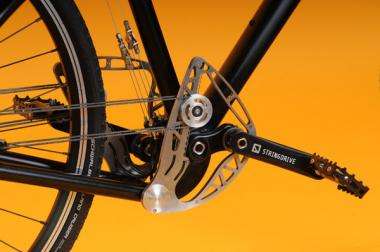September 22, 2010 report
Introducing Stringbike: the bike with no chain (w/ Video)

(PhysOrg.com) -- Hungarian bicycle designers have unveiled their new Stringbike in Padova, Italy. The design replaces the traditional chain with a symmetrical rope and pulley system, which they say is more efficient, makes for a more comfortable ride, and provides improved maneuverability around winding streets.
The new system is more complex than a chain and gears and consists of a rope and pulley on each side of the bike. The rotation of the pedals forces arms at each side to swing forward and backward on its shaft. When moving forward, the arm pulls the driving wire that is wound around a drum on the rear wheel, forcing the wheel to rotate. The arms at each side alternate so that when one is moving forward the other is moving backward.
The new system has 19 "gear" positions and the transmission ratio can be changed at any time by turning a shifting knob on the right handle grip. This moves the pulley shafts up and down along a traction path on an eccentric disc, which has 19 notches to adjust the height of the pulleys and distance between the center of rotation and the shaft. The gears can be changed even if the bicycle is stationary, but gear change speed increases with the speed of the bicycle.

The drive system will be able to be replaced with different size parts and different shaped eccentric discs for specialized purposes such as racing or touring. The rear wheel can be removed in only a few seconds without affecting the drive system. The driving rope is a special high density polyethylene (HDPE) product with high stability over extended periods, and which is resistant to mud, water, dirt, sand, and humidity.
The traditional bicycle has a chain and gears on one side, which the designers from bicycle manufacturer Schwinn Csepel Zrt say has led to a lot of problems, although they do not say exactly what those problems are. They say most are unnoticeable problems until you’ve actually ridden a symmetrical system. One problem that the new design does remove is soiling clothes with the grease or oil on the chain, since the pulley system is dry.
Another advantage of the system is that the ropes can be attached in different positions on the two sides of the bicycle, which means it can compensate if one of the rider’s legs is weaker than the other. The designers also say the lifetime of components will be longer than for conventional bicycles because chains are more susceptible to wear and abrasion, and the number of components is reduced.
More information: www.stringbike.com/
© 2010 PhysOrg.com



















